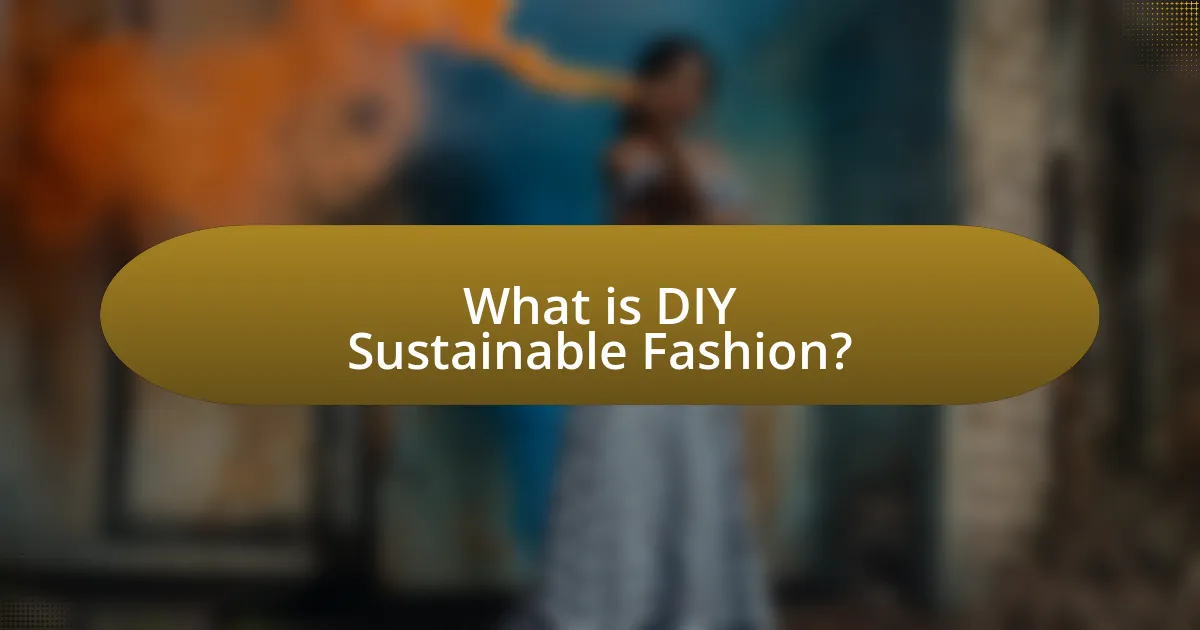DIY Sustainable Fashion is the practice of creating or modifying clothing and accessories in an environmentally friendly manner, primarily through upcycling and repurposing materials. This approach significantly reduces textile waste and minimizes the carbon footprint associated with clothing production, addressing the fashion industry’s substantial contribution to global carbon emissions. The article explores various aspects of DIY Sustainable Fashion, including the materials commonly used, the benefits of revamping wardrobes, popular upcycling techniques, and practical tips for implementing sustainable practices. It emphasizes the importance of personal style in making sustainable choices and provides resources for learning DIY techniques while addressing common challenges faced in this creative endeavor.

What is DIY Sustainable Fashion?
DIY Sustainable Fashion is the practice of creating or modifying clothing and accessories in an environmentally friendly manner, often using upcycled or repurposed materials. This approach reduces waste and promotes sustainability by encouraging individuals to take control of their wardrobe, rather than relying on fast fashion. According to a report by the Ellen MacArthur Foundation, the fashion industry is responsible for 10% of global carbon emissions, highlighting the importance of sustainable practices like DIY fashion in mitigating environmental impact.
How does DIY Sustainable Fashion contribute to environmental conservation?
DIY Sustainable Fashion contributes to environmental conservation by reducing waste and minimizing the carbon footprint associated with clothing production. By repurposing old garments and using sustainable materials, individuals can significantly decrease the demand for new clothing, which is responsible for approximately 10% of global carbon emissions. Additionally, DIY practices often involve local sourcing of materials, further lowering transportation emissions and supporting local economies. This approach not only conserves resources but also promotes a culture of sustainability, encouraging others to adopt eco-friendly practices in their fashion choices.
What materials are commonly used in DIY Sustainable Fashion projects?
Common materials used in DIY Sustainable Fashion projects include organic cotton, linen, hemp, recycled fabrics, and upcycled materials. Organic cotton is favored for its minimal environmental impact, as it is grown without synthetic pesticides and fertilizers. Linen, made from flax plants, is biodegradable and requires less water than conventional cotton. Hemp is another eco-friendly option, known for its durability and low resource requirements. Recycled fabrics, such as those sourced from old garments or textile waste, help reduce landfill contributions. Upcycled materials, which repurpose existing items, promote creativity and sustainability in fashion design.
How can DIY Sustainable Fashion reduce textile waste?
DIY Sustainable Fashion can significantly reduce textile waste by encouraging the repurposing and upcycling of existing garments. This practice minimizes the need for new materials, thereby decreasing the overall demand for textile production, which is a major contributor to waste. According to the Ellen MacArthur Foundation, the fashion industry generates over 92 million tons of waste annually, much of which comes from discarded clothing. By engaging in DIY projects, individuals can transform old clothes into new items, extending their lifecycle and reducing landfill contributions.
Why is revamping your wardrobe important?
Revamping your wardrobe is important because it promotes sustainability and personal expression. By updating clothing choices, individuals can reduce waste and minimize their environmental impact, as the fashion industry is responsible for significant pollution and resource depletion. According to the Ellen MacArthur Foundation, the fashion industry contributes to 10% of global carbon emissions, highlighting the need for more sustainable practices. Additionally, a refreshed wardrobe allows individuals to better reflect their current style and identity, fostering confidence and self-esteem.
What are the benefits of a sustainable wardrobe overhaul?
A sustainable wardrobe overhaul reduces environmental impact by minimizing waste and promoting ethical consumption. This approach encourages the use of eco-friendly materials, which can significantly lower carbon emissions associated with clothing production. For instance, the fashion industry is responsible for approximately 10% of global carbon emissions, and adopting sustainable practices can help mitigate this issue. Additionally, a sustainable wardrobe promotes longevity in clothing, reducing the frequency of purchases and fostering a more mindful approach to fashion. Studies indicate that extending the life of garments by just nine months can reduce their carbon, water, and waste footprints by 20-30%. Overall, a sustainable wardrobe overhaul not only benefits the environment but also encourages personal responsibility and awareness in fashion choices.
How does personal style influence sustainable fashion choices?
Personal style significantly influences sustainable fashion choices by guiding individuals in selecting clothing that aligns with their aesthetic preferences while prioritizing eco-friendly materials and ethical production methods. When consumers express their unique style, they often seek out brands that reflect their values, such as sustainability and social responsibility. For instance, a study published in the Journal of Fashion Marketing and Management found that consumers who identify strongly with their personal style are more likely to invest in sustainable fashion, as they perceive it as an extension of their identity. This connection between personal style and sustainable choices encourages a more thoughtful approach to consumption, leading to reduced waste and a preference for timeless, versatile pieces over fast fashion trends.

What creative ways can you revamp your wardrobe?
To revamp your wardrobe creatively, consider upcycling old clothing into new pieces, such as transforming a dress into a skirt or a shirt into a tote bag. This method not only refreshes your style but also promotes sustainability by reducing waste. According to a study by the Ellen MacArthur Foundation, extending the life of clothing by just nine months can reduce carbon, water, and waste footprints by 20-30%. Additionally, experimenting with layering, mixing patterns, and accessorizing can breathe new life into existing outfits, allowing for unique combinations that reflect personal style.
How can upcycling transform old clothing into new fashion pieces?
Upcycling transforms old clothing into new fashion pieces by creatively repurposing materials to create unique garments. This process involves techniques such as sewing, dyeing, and embellishing, allowing individuals to design one-of-a-kind items that reflect personal style while reducing waste. According to a study by the Ellen MacArthur Foundation, upcycling can significantly decrease the environmental impact of the fashion industry by extending the lifecycle of textiles, thereby conserving resources and minimizing landfill contributions.
What are some popular upcycling techniques for clothing?
Popular upcycling techniques for clothing include patchwork, where old fabric pieces are sewn together to create new designs; tie-dye, which involves dyeing fabric in unique patterns; and transforming garments, such as turning a dress into a top or a pair of jeans into a bag. These methods not only reduce waste but also allow for personalized fashion statements. For instance, patchwork has historical roots in various cultures, showcasing its long-standing appeal and sustainability benefits.
How can you incorporate upcycled pieces into your daily outfits?
Incorporating upcycled pieces into daily outfits can be achieved by mixing them with contemporary clothing to create unique styles. For example, pairing an upcycled denim jacket with a simple dress or combining upcycled accessories, like bags or jewelry, with everyday attire can enhance your look while promoting sustainability. Studies show that upcycling not only reduces waste but also encourages creativity in fashion choices, making it a practical approach to personal style.
What role does customization play in DIY Sustainable Fashion?
Customization plays a crucial role in DIY sustainable fashion by allowing individuals to create unique garments that reflect personal style while minimizing waste. This approach encourages the repurposing of existing clothing, which reduces the demand for new textiles and lowers the environmental impact associated with fast fashion. According to a study published in the Journal of Fashion Marketing and Management, customization in fashion not only enhances consumer satisfaction but also promotes sustainable practices by extending the lifecycle of garments. By engaging in customization, individuals contribute to a more sustainable fashion ecosystem through creativity and resourcefulness.
How can you personalize your clothing to reflect your style?
You can personalize your clothing to reflect your style by incorporating unique elements such as custom embroidery, fabric paint, or patches. Custom embroidery allows you to add initials, symbols, or designs that resonate with your personal identity, while fabric paint enables you to create one-of-a-kind patterns or artwork directly on your garments. Additionally, sewing on patches can showcase your interests or affiliations, making your clothing distinctly yours. According to a study published in the Journal of Fashion Marketing and Management, personalization in fashion enhances consumer satisfaction and emotional connection to clothing, demonstrating that these methods effectively create a stronger personal style.
What tools and materials do you need for clothing customization?
For clothing customization, essential tools and materials include fabric scissors, sewing needles, thread, fabric glue, and embellishments such as patches or beads. Fabric scissors are necessary for precise cutting, while sewing needles and thread allow for stitching alterations or repairs. Fabric glue provides a no-sew option for attaching decorations, and embellishments enhance the design. These tools and materials enable effective customization, allowing individuals to personalize their clothing sustainably.

What are some practical tips for implementing DIY Sustainable Fashion?
To implement DIY Sustainable Fashion, start by upcycling old clothing items instead of discarding them. This practice reduces waste and extends the life of garments. For example, transforming a worn-out pair of jeans into a stylish bag not only repurposes fabric but also minimizes the need for new materials. Additionally, consider using natural dyes from plants or food waste to color fabrics, which is an eco-friendly alternative to synthetic dyes that can harm the environment. Research indicates that the fashion industry is responsible for 10% of global carbon emissions, highlighting the importance of sustainable practices. By adopting these methods, individuals can contribute to reducing their environmental footprint while expressing creativity in their wardrobe.
How can you start your DIY Sustainable Fashion journey?
To start your DIY Sustainable Fashion journey, begin by assessing your current wardrobe to identify items that can be repurposed or upcycled. This approach not only reduces waste but also encourages creativity in transforming old garments into new pieces. For instance, according to a study by the Ellen MacArthur Foundation, extending the life of clothing by just nine months can reduce carbon, water, and waste footprints by 20-30%. Therefore, focusing on upcycling and repurposing existing clothing is a sustainable practice that contributes positively to the environment.
What resources are available for learning DIY techniques?
Online platforms such as YouTube, Pinterest, and DIY blogs provide extensive resources for learning DIY techniques. YouTube hosts countless tutorial videos that cover various DIY projects, while Pinterest offers a plethora of visual inspiration and step-by-step guides. Additionally, DIY blogs often feature detailed articles and resources, including materials lists and project instructions, specifically tailored to sustainable fashion. These platforms collectively serve as valuable tools for individuals looking to enhance their DIY skills in revamping their wardrobes sustainably.
How can you find inspiration for your DIY projects?
To find inspiration for your DIY projects, explore online platforms like Pinterest and Instagram, where users share creative ideas and tutorials. These platforms host a vast array of images and step-by-step guides that can spark your imagination. Additionally, visiting local thrift stores or flea markets can provide unique materials and styles that inspire new projects. Engaging with DIY communities, both online and offline, allows for the exchange of ideas and techniques, further enhancing your creative process. Research shows that visual stimuli, such as images and videos, significantly boost creativity, making these platforms effective sources of inspiration.
What common challenges might you face in DIY Sustainable Fashion?
Common challenges in DIY Sustainable Fashion include sourcing eco-friendly materials, acquiring the necessary skills for garment construction, and managing time effectively for projects. Sourcing sustainable fabrics can be difficult due to limited availability and higher costs compared to conventional materials. Additionally, individuals may lack sewing or crafting skills, which can hinder their ability to create or alter garments. Time management poses another challenge, as DIY projects often require significant time investment for planning, execution, and potential revisions. These challenges are supported by studies indicating that many DIY enthusiasts struggle with material accessibility and skill development, impacting their overall success in sustainable fashion initiatives.
How can you overcome obstacles in sourcing materials?
To overcome obstacles in sourcing materials for DIY sustainable fashion, one can establish strong relationships with local suppliers and explore alternative materials. Building connections with local suppliers can provide access to unique, sustainable fabrics and reduce shipping costs, while exploring alternatives like upcycled materials or natural fibers can expand sourcing options. According to a report by the Ellen MacArthur Foundation, utilizing upcycled materials can significantly reduce waste and promote sustainability in fashion, demonstrating the effectiveness of these strategies.
What strategies can help you stay motivated in your DIY projects?
To stay motivated in DIY projects, set clear, achievable goals and break tasks into manageable steps. This approach allows for a sense of accomplishment as each step is completed, which reinforces motivation. Research indicates that goal-setting enhances performance and persistence in creative tasks, as outlined in the study “The Effects of Goal Setting on Performance” by Locke and Latham. Additionally, creating a dedicated workspace and surrounding yourself with inspiring materials can further boost motivation by fostering a conducive environment for creativity.
What are the best practices for maintaining a sustainable wardrobe?
The best practices for maintaining a sustainable wardrobe include choosing high-quality, durable clothing, practicing mindful consumption, and caring for garments properly. High-quality clothing lasts longer, reducing the need for frequent replacements, which is supported by the fact that the average consumer discards 81 pounds of clothing each year, contributing to landfill waste. Mindful consumption involves purchasing only what is necessary and opting for second-hand or ethically produced items, as studies show that fast fashion contributes significantly to environmental degradation. Proper garment care, such as washing in cold water and air drying, extends the life of clothing, which can reduce the environmental impact associated with production and disposal.

Leave a Reply